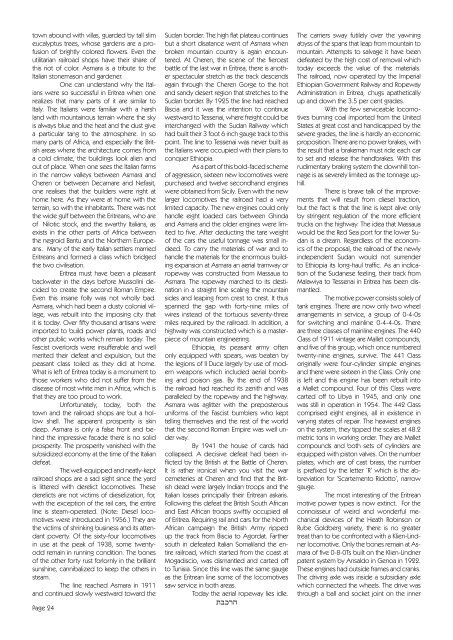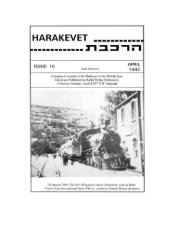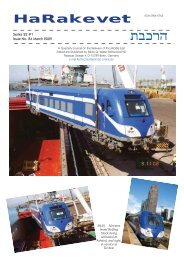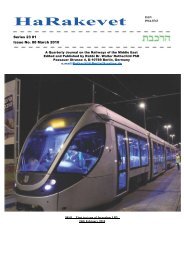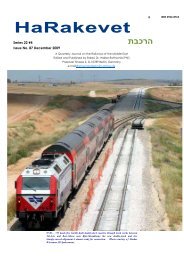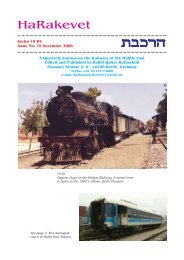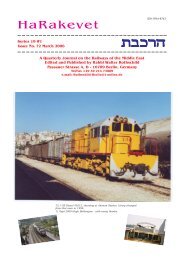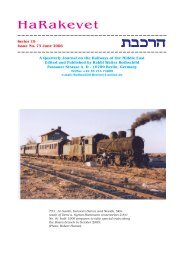Create successful ePaper yourself
Turn your PDF publications into a flip-book with our unique Google optimized e-Paper software.
town abound with villas, guarded by tall slim<br />
eucalyptus trees, whose gardens are a profusion<br />
of brightly colored flowers. Even the<br />
utilitarian railroad shops have their share of<br />
this riot of color. Asmara is a tribute to the<br />
Italian stonemason and gardener.<br />
One can understand why the Italians<br />
were so successful in Eritrea when one<br />
realizes that many parts of it are similar to<br />
Italy. The Italians were familiar with a harsh<br />
land with mountainous terrain where the sky<br />
is always blue and the heat and the dust give<br />
a particular tang to the atmosphere. In so<br />
many parts of Africa, and especially the British<br />
areas where the architecture comes from<br />
a cold climate, the buildings look alien and<br />
out of place. When one sees the Italian farms<br />
in the narrow valleys between Asmara and<br />
Cheren or between Decamare and Nefasit,<br />
one realises that the builders were right at<br />
home here. As they were at home with the<br />
terrain, so with the inhabitants. There was not<br />
the wide gulf between the Eritreans, who are<br />
of Nilotic stock, and the swarthy Italians, as<br />
exists in the other parts of Africa between<br />
the negroid Bantu and the Northern Europeans.<br />
Many of the early Italian settlers married<br />
Eritreans and formed a class which bridged<br />
the two civilisation.<br />
Eritrea must have been a pleasant<br />
backwater in the days before Mussolini decided<br />
to create the second Roman Empire.<br />
Even this insane folly was not wholly bad.<br />
Asmara, which had been a dusty colonial village,<br />
was rebuilt into the imposing city that<br />
it is today. Over fifty thousand artisans were<br />
imported to build power plants, roads and<br />
other public works which remain today. The<br />
Fascist overlords were insufferable and well<br />
merited their defeat and expulsion, but the<br />
peasant class toiled as they did at home.<br />
What is left of Eritrea today is a monument to<br />
those workers who did not suffer from the<br />
disease of most white men in Africa, which is<br />
that they are too proud to work.<br />
Unfortunately, today, both the<br />
town and the railroad shops are but a hollow<br />
shell. The apparent prosperity is skin<br />
deep. Asmara is only a false front and behind<br />
the impressive facade there is no solid<br />
prosperity. The prosperity vanished with the<br />
subsidized economy at the time of the Italian<br />
defeat.<br />
The well-equipped and neatly-kept<br />
railroad shops are a sad sight since the yard<br />
is littered with derelict locomotives. These<br />
derelicts are not victims of dieselization, for,<br />
with the exception of the rail cars, the entire<br />
line is steam-operated. (Note: Diesel locomotives<br />
were introduced in 1956.) They are<br />
the victims of shrinking business and its attendant<br />
poverty. Of the sixty-four locomotives<br />
in use at the peak of 1938, some twentyodd<br />
remain in running condition. The bones<br />
of the other forty rust forlornly in the brilliant<br />
sunshine, cannibalized to keep the others in<br />
steam.<br />
The line reached Asmara in 1<strong>91</strong>1<br />
and continued slowly westward toward the<br />
Page 24<br />
Sudan border. The high flat plateau continues<br />
but a short disatance went of Asmara when<br />
broken mountain country is again encountered.<br />
At Cheren, the scene of the fiercest<br />
battle of the last war in Eritrea, there is another<br />
spectacular stretch as the track descends<br />
again through the Cheren Gorge to the hot<br />
and sandy desert region that stretches to the<br />
Sudan border. By 1925 the line had reached<br />
Biscia and it was the intention to continue<br />
westward to Tessenai, where freight could be<br />
interchanged with the Sudan Railway which<br />
had built their 3 foot 6 inch gauge track to this<br />
point. The line to Tessenai was never built as<br />
the Italians were occupied with their plans to<br />
conquer Ethiopia.<br />
As a part of this bold-faced scheme<br />
of aggression, sixteen new locomotives were<br />
purchased and twelve secondhand engines<br />
were obtained from Sicily. Even with the new<br />
larger locomotives the railroad had a very<br />
limited capacity. The new engines could only<br />
handle eight loaded cars between Ghinda<br />
and Asmara and the older engines were limited<br />
to five. After deducting the tare weight<br />
of the cars the useful tonnage was small indeed.<br />
To carry the materials of war and to<br />
handle the materials for the enormous building<br />
expansion at Asmara an aerial tramway or<br />
ropeway was constructed from Massaua to<br />
Asmara. The ropeway marched to its destination<br />
in a straight line scaling the mountain<br />
sides and leaping from crest to crest. It thus<br />
spanned the gap with forty-nine miles of<br />
wires instead of the tortuous seventy-three<br />
miles required by the railroad. In addition, a<br />
highway was constructed which is a masterpiece<br />
of mountain engineering.<br />
Ethiopia, its peasant army often<br />
only equipped with spears, was beaten by<br />
the legions of Il Duce largely by use of modern<br />
weapons which included aerial bombing<br />
and poison gas. By the end of 1938<br />
the railroad had reached its zenith and was<br />
paralleled by the ropeway and the highway.<br />
Asmara was aglitter with the preposterous<br />
uniforms of the Fascist bumblers who kept<br />
telling themselves and the rest of the world<br />
that the second Roman Empire was well under<br />
way.<br />
By 1941 the house of cards had<br />
collapsed. A decisive defeat had been inflicted<br />
by the British at the Battle of Cheren.<br />
It is rather ironical when you visit the war<br />
cemeteries at Cheren and find that the British<br />
dead were largely Indian troops and the<br />
Italian losses principally their Eritrean askaris.<br />
Following this defeat the British South African<br />
and East African troops swiftly occupied all<br />
of Eritrea. Requiring rail and cars for the North<br />
African campaign the British Army ripped<br />
up the track from Biscia to Agordat. Farther<br />
south in defeated Italian Somaliland the entire<br />
railroad, which started from the coast at<br />
Mogadiscio, was dismantled and carted off<br />
to Tunisia. Since this line was the same gauge<br />
as the Eritrean line some of the locomotives<br />
saw service in both areas.<br />
Today the aerial ropeway lies idle.<br />
,cfrv<br />
The carriers sway futilely over the yawning<br />
abyss of the spans that leap from mountain to<br />
mountain. Attempts to salvage it have been<br />
defeated by the high cost of removal which<br />
today exceeds the value of the materials.<br />
The railroad, now operated by the Imperial<br />
Ethiopian Government Railway and Ropeway<br />
Administration in Eritrea, chugs apathetically<br />
up and down the 3.5 per cent grades.<br />
With the few serviceable locomotives<br />
burning coal imported from the United<br />
States at great cost and handicapped by the<br />
severe grades, the line is hardly an economic<br />
proposition. There are no power brakes, with<br />
the result that a brakeman must ride each car<br />
to set and release the handbrakes. With this<br />
rudimentary braking system the downhill tonnage<br />
is as severely limited as the tonnage uphill.<br />
There is brave talk of the improvements<br />
that will result from diesel traction,<br />
but the fact is that the line is kept alive only<br />
by stringent regulation of the more efficient<br />
trucks on the highway. The idea that Massaua<br />
would be the Red Sea port for the lower Sudan<br />
is a dream. Regardless of the economics<br />
of the proposal, the railroad of the newly<br />
independent Sudan would not surrender<br />
to Ethiopia its long-haul traffic. As an indication<br />
of the Sudanese feeling, their track from<br />
Malawiya to Tessenai in Eritrea has been dismantled.<br />
The motive power consists solely of<br />
tank engines. There are now only two wheel<br />
arrangements in service, a group of 0-4-0s<br />
for switching and mainline 0-4-4-0s. There<br />
are three classes of mainline engines. The 440<br />
Class of 1<strong>91</strong>1 vintage are Mallet compounds,<br />
and five of this group, which once numbered<br />
twenty-nine engines, survive. The 441 Class<br />
originally were four-cylinder simple engines<br />
and there were sixteen in the Class. Only one<br />
is left and this engine has been rebuilt into<br />
a Mallet compound. Four of this Class were<br />
carted off to Libya in 1945, and only one<br />
was still in operation in 1954. The 442 Class<br />
comprised eight engines, all in existence in<br />
varying states of repair. The heaviest engines<br />
on the system, they tipped the scales at 48.2<br />
metric tons in working order. They are Mallet<br />
compounds and both sets of cylinders are<br />
equipped with piston valves. On the number<br />
plates, which are of cast brass, the number<br />
is prefixed by the letter ‘R’ which is the abbreviation<br />
for ‘Scartemento Ridotto’, narrow<br />
gauge.<br />
The most interesting of the Eritrean<br />
motive power types is now extinct. For the<br />
connoisseur of weird and wonderful mechanical<br />
devices of the Heath Robinson or<br />
Rube Goldberg variety, there is no greater<br />
treat than to be confronted with a Klien-Lindner<br />
locomotive. Only the bones remain at Asmara<br />
of five 0-8-0Ts built on the Klien-Lindner<br />
patent system by Ansaldo in Genoa in 1922.<br />
These engines had outside frames and cranks.<br />
The driving axle was inside a subsidiary axle<br />
which connected the wheels. The drive was<br />
through a ball and socket joint on the inner


